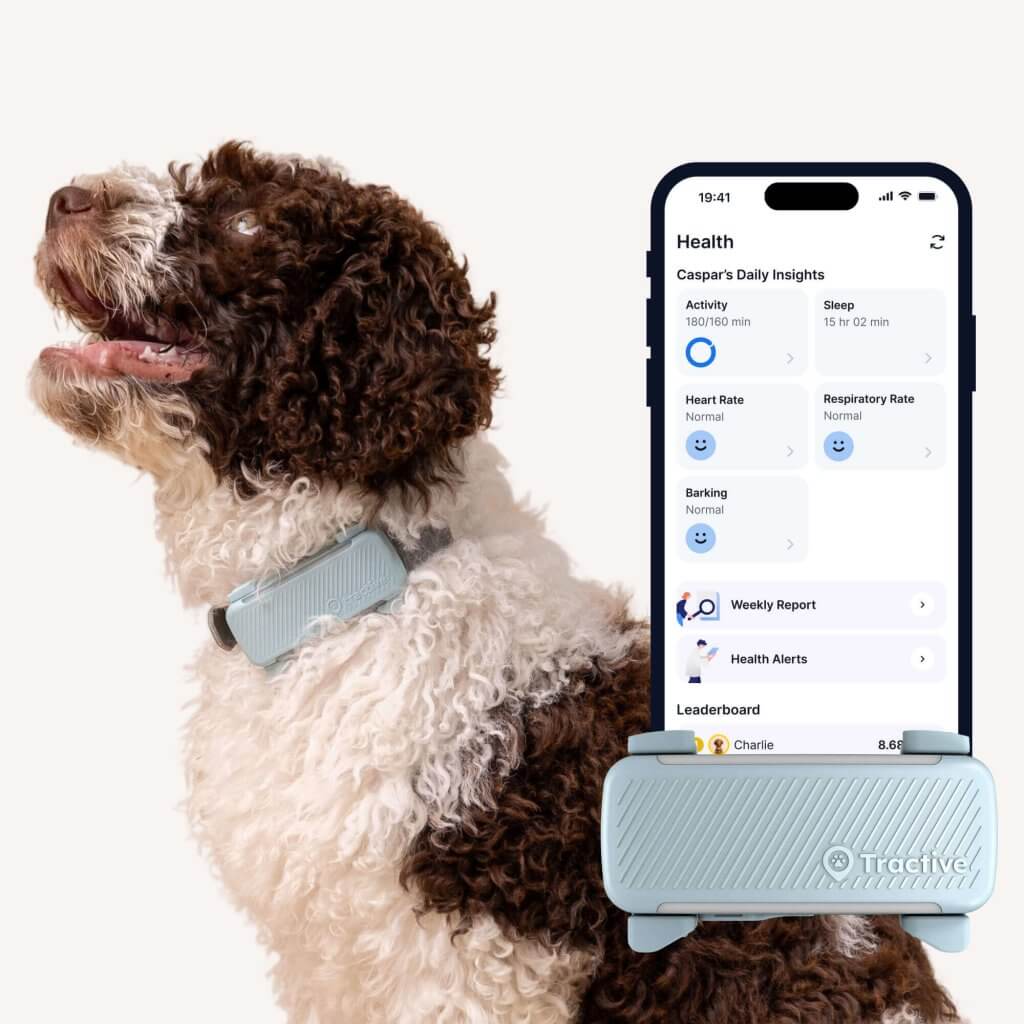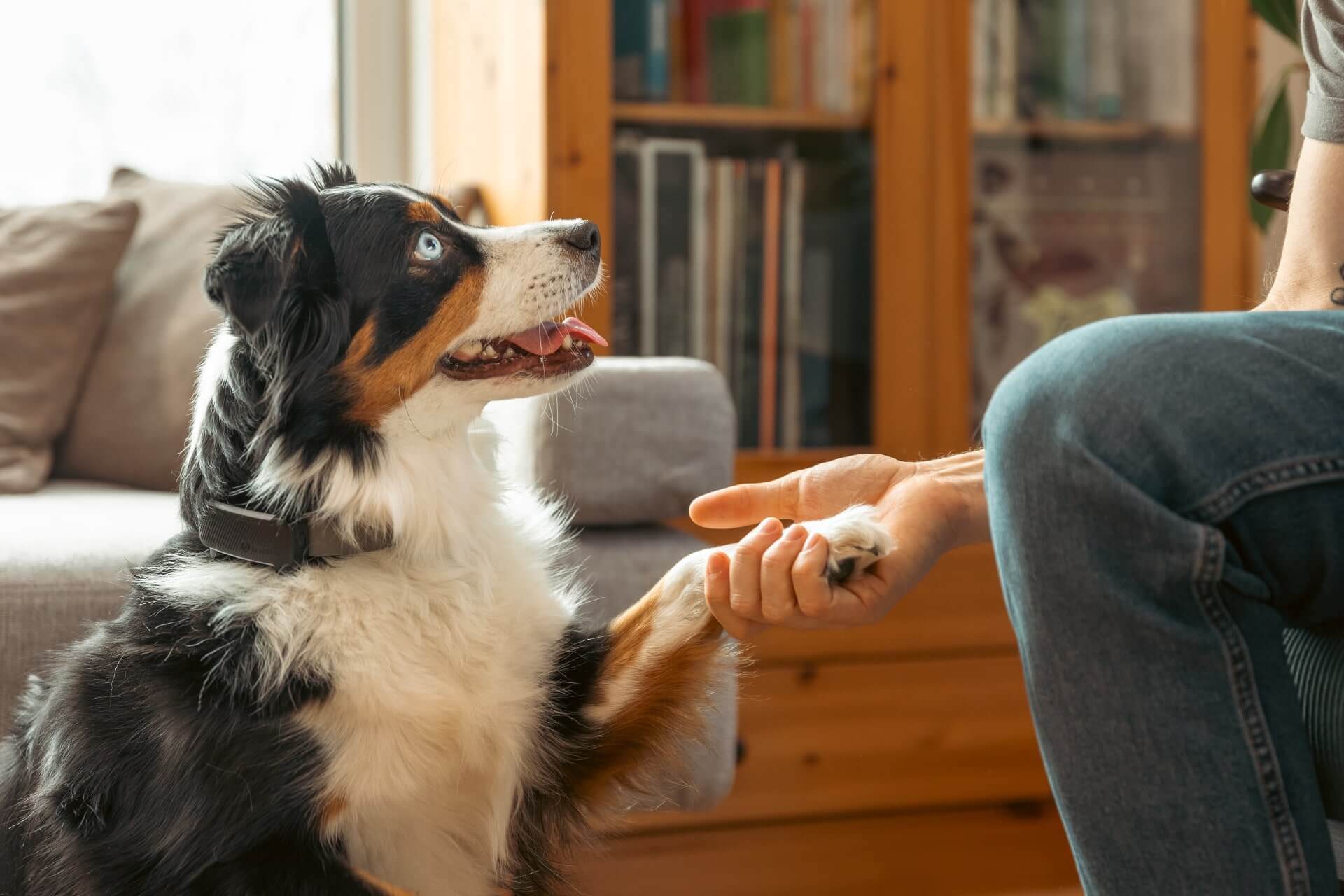 Approved by Dr. Dwight Alleyne, DVM
Approved by Dr. Dwight Alleyne, DVM Managing Anxiety In Dogs: Your Ultimate Guide
Whether it's due to loud noises, you leaving for work, growing older, or the presence of other pets or people - anxiety in dogs can be challenging to handle. So here's how to spot the signs - and set your buddy up for success in managing it.
Just like us humans, anxiety in dogs can turn up in some distressing ways. But on the bright side, with a little knowledge and some practical steps, you can help reduce your dog’s anxiety, learn what triggers it in the first place, spot the signs, and improve their quality of life. (Plus, how to monitor your dog remotely for any signs of anxiety – like barking or restless pacing.) Here’s how.
Key Takeaways
😟 Dog anxiety tends to show up in behaviors like excessive barking, pacing, or destructiveness.
🐕 Life experience – more than breed – often plays the biggest role in whether a dog struggles with anxiety.
🩺 Consulting your vet is a key step in managing anxiety, whether to rule out medical causes or to tailor a care plan.
🐶 A smart GPS & Health Tracker like Tractive can help detect early signs of anxiety through bark monitoring, activity tracking, and separation alerts.

Always know your buddy is healthy & safe
Read moreWhere your dog’s anxiety might all begin
Just like with us, dogs can also be anxiety-prone for a whole bunch of reasons. More often than not, it could be your buddy’s experiences in early life that can set the stage for them developing anxiety around specific triggers. Which could include:
- Neglect
Whether from Mama dog or other humans who should’ve cared better for them - Trauma or violence
Likely from former owners. (Or even in the case of some working dogs that might’ve worked in police or K-9 units) - Other learned behaviors
Like when puppies learn to bark, hide, or cower at the sound of thunder. Or when their caregiver leaves – because they’ve seen other dogs or puppies around them do just that. - A lack of socialization
Where your little buddy might not have been introduced to new environments, people, or other animals. This can make your dog stressed out and overwhelmed at such experiences. This anxiety can carry on into adulthood. - Or some combination thereof
Now you might think it’s easier to help puppies adjust to “new” experiences. (Especially if you’ve just adopted them and are introducing them to a safe, loving new home.) But adult dogs can adapt equally well and learn to overcome their fears with time and patience.
What are some signs of anxiety in dogs?
Dog anxiety can turn up in a bunch of ways, since it can vary depending on what’s triggering it. But knowing what to look for can help you address what’s bothering your buddy – and take action right away. So keep an eye out for:
| Physical signs | Behavioral signs |
| – Dilated eyes, showing the whites – A low, tucked tail – Licking lips, – Ears drawn back, – Trembling, – Panting, – Shaking – Drooling – An elevated heartbeat | – Restless pacing, constant moving around or being unable to settle – Excessive vocalization, including barking, whining, even howling – Destructive behaviors, like chewing up slippers or furniture or even scratching at doors – Hiding behaviors, including under your bed or in a quiet corner of your house as a way to “escape.” – Clinginess or demanding attention |
What can trigger anxiety in dogs?
- A big change in routine
Like if you’ve shifted apartments or just adopted them. Or brought home a new pet or baby, or even switched up your own routine. Give your dog some time to adjust and don’t skip out on any quality time together. - Separation anxiety
If your dog becomes a nervous wreck when you leave for work, it could be due to separation anxiety. Practising gradual departures can help your dog slowly learn that you “disappearing” = “no big deal.” (Because you will eventually return!) - Noise anxiety
From fireworks, thunderstorms, or even construction or passing cars outdoors. Mask the loud sounds with white noise or calming music, or consider counter-conditioning your dog’s “scared” response to the loud noise instead. - Growing older
Senior dogs might experience a loss of mobility or senses, including cognitive decline. All of which can trigger anxious barking or vocalizing at night, since they might feel confused or disoriented.
If your dog’s anxiety persists even after you take action – get in touch with your vet. They can best advise you what other steps to take and if your dog might benefit from anti-anxiety medication or even help from a professional dog behaviorist.

Get health alerts for your dog
Our pups can’t always tell us if something’s wrong. But if their tracker detects unusual changes in their routine, you’ll get an alert, helping you catch potential issues early.
Are some dogs more prone to anxiety than others?
Just like humans, every dog is different – and while breed can sometimes play a role in anxiety levels, it’s really a dog’s entire life experience that shapes how they cope with stress. With that said, here are some types of dogs that may be more prone to anxiety:
- Rescue dogs or those with a traumatic past
- Dogs who’ve been rehomed multiple times
- Breeds known for high intelligence and sensitivity (like Border Collies, Australian Shepherds, or Poodles)
- Dogs who are left alone for long periods
- Older dogs experiencing cognitive decline
- Dogs with limited early socialization
While this information can be helpful – especially when you’re adopting a dog or discussing concerns with your vet – it’s important not to make assumptions based solely on breed. Every dog has their own personality and background, and staying informed helps you better support their emotional well-being.
How to calm an anxious dog
Depending on what tends to trigger your dog’s anxiety, you’ve got a couple of options if you’re wondering how to calm an anxious dog. For example, you could try:
Calming tools
- Thundershirts, weighted blankets, or snug-fitting anxiety wraps that provide gentle pressure – kind of like swaddling a baby. (Though do make sure to get the green light from your vet first.)
- Spritz a blanket or sweater with some lavender or chamomile and leave it behind for your dog if you have to head out for work. These scents can be calming and help reduce their stress.
- Some chews or supplements can contain ingredients like chamomile, which can also help your dog feel calmer.
- A pheromone diffuser can mimic the natural pheromones released by mother dogs. Consider installing one indoors when you’re not around and have to leave your dog at home alone.
Regular training
Regular basic obedience training can actually help an anxious dog feel more grounded and secure. Especially since it also means time they spend with you in a structured environment, establishing boundaries, and helping them learn what’s “good” behavior and what isn’t.
So don’t skip out on basic commands like “Sit,” “Stay,” and “Drop it,” – especially if your buddy tends to chew the nearest object when anxious or paces around endlessly.
In more serious cases, don’t hesitate to reach out to a professional dog training school or expert in your locality. This is another opportunity for your buddy to socialize, learn some commands from the pros, and for you to pick up some training tips and experience all in one.
Supervised outdoor time
Confining a nervous dog indoors isn’t always ideal. (Especially when the weather’s nice enough to head out for a walk or to the park!) Rather, you’re better off ensuring you’re present any time you and your buddy venture outdoors. Staying close to your buddy means you can intervene at a moment’s notice if you notice them showing any signs of anxiety – and help them slowly learn that it isn’t so scary outdoors, after all.
So make sure you:
- Keep your buddy leashed while out on walks together. Be firm but kind with fellow dog parents, especially if your dog doesn’t like being approached by others.
- Stick around if you’re playing together in the backyard. A lone dog in a backyard could be a prime target for dog thieves!
- While you don’t need to hover over your dog at a dog park, make sure you’re close enough that they can retreat back to you as a “safe place” when they need.
Daily walks and playtime help you two spend some quality time together, stay healthy, and also help your dog release any pent-up energy or anxiety.
Consult your vet
If your dog shows ongoing signs of anxiety – like excessive barking, pacing, destructive behavior, or sudden changes in appetite or sleep – it’s a good idea to drop by for a checkup. Anxiety can sometimes be linked to underlying medical issues or might require professional behavioral support. A vet can:
- Rule out any medical causes for your dog’s anxious behavior
- Recommend calming techniques or environmental changes
- Suggest behavior training, calming supplements, or medications if needed
- Interpret tracking data from devices like Tractive to spot trends or patterns
Where a smart tracker with GPS & Health tracking can help
When managing anxiety in dogs – especially separation anxiety – having the right tools can make a world of difference. That’s where a smart tracker like the Tractive GPS & Health Tracker comes in. With features like Bark Monitoring and Separation Anxiety Alerts, it helps you keep tabs on your dog’s emotional well-being, even when you’re not home.

Here’s how it supports you and your furry friend:
- Bark monitoring
Get insights into how much your dog is barking when you’re away. A sudden spike in barking could be a sign of stress, anxiety, or discomfort.

- Separation Anxiety monitoring
Just switch on your monitor before leaving home, so your tracker can monitor your dog for signs of anxiety – like barking or restless pacing. You’ll get an alert if something seems amiss, so you can check in or take action.

- Health & Activity tracking
Monitor your dog’s activity levels and sleep patterns to detect potential anxiety-related changes, like restlessness or lethargy. If there’s a weird drop in your dog’s active minutes or a decline in their sleep quality, your tracker will send you a Health Alert. - Location Tracking
Know where your dog is at all times, and set up safe zones to get notified if they wander – especially useful if they tend to bolt during moments of panic.
So whether you’re at work or running errands, you can monitor your dog’s behavior and get peace of mind, even from a distance. Plus, you can use the insights from your Tractive device to talk to your vet or trainer and tailor solutions that work best for your dog.
With Tractive, you’re not just watching your dog – you’re truly understanding them, and that’s the first step toward managing anxiety in a calm, informed way.
Your furry friend’s health and wellbeing means as much as to us as it does to you. So we’ve made it a priority to only share medically-relevant content on our blog. This post was checked, double-checked, and medically verified by Georgia-based vet, Dr. Dwight Alleyne.

Dr. Dwight Alleyne, DVM
Originally from Long Island, New York, Dr. Alleyne began his career at a no-kill animal shelter before becoming a licensed veterinary technician. He graduated from Cornell University Veterinary College in 2006 and completed an internship at Purdue University. Now practicing in Georgia, Dr. Alleyne specializes in soft tissue surgery and ultrasounds. He also writes pet health articles on his website, “The Animal Doctor Blog” (www.anmldrblog.com).



